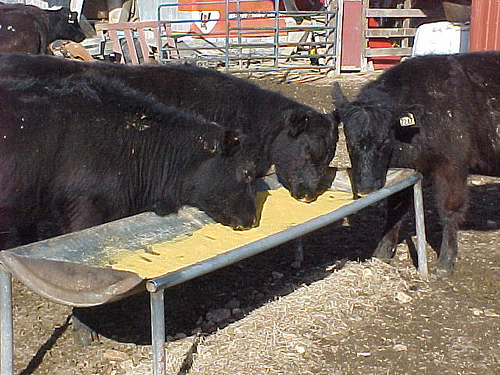
Cows eating something besides cyanide. (Photo courtesy of the University of Missouri Extension.)
Perhaps you heard the story going around today. A genetically modified grass started pumping out cyanide gas, killing a herd of cattle. CBS News had the scoop, as seen at WTVR.com in Richmond: “Genetically modified grass linked to cattle deaths.” It’s basically a story custom-built for rapid spread around the internet.
And it is basically completely wrong. The grass at issue, Tifton 85, was not genetically modified at all, but rather is a hybrid. Confusion between hybridized crops (which is a process that is basically as old as the idea of “crops”) and GMOs is not uncommon.
Nor did the plants suddenly start pumping out cyanide. Examiner.com was one of the first sites with a refutation of the story from which we excerpt this explanation:
According to local station KEYE, Abel first knew something was wrong when the cows started bellowing. He thought he was about to witness a calving but instead saw his unfortunate animals staggering around, obviously dying. Others in the area have also since tested their grass and found the same results—the grass has started venting cyanide.
True: Cattle died after eating grass that suddenly started venting cyanide [Update: the animals died of prussic acid or hydrogen cyanide poisoning.]
False: The grass was genetically modified
Reports indicate that the culprit was indeed prussic acid poisoning, a well-documented, if uncommon, threat to cattle.
The University of Wyoming writes:
Prussic acid or hydrogen cyanide poisoning arises from the release of emulsin, which is found primarily in plant tissue of the sorghum family, and interaction with dhurrin, also found in these same crops. Damage to plants, such as freezing, trampling, chewing results in the interaction of these two plant compounds and the creation of hydrogen cyanide (HCN). …
Probably the most common cause of prussic acid poisoning in sorghums is drought. Drought-stricken plants consist mainly of leaves. Animal poisoning can result from grazing or green chop feeding. Regrowth following drought can have deadly concentrations.
Tifton 85 is not a sorghum, but the point is clear: There is a risk to livestock from the mixture of plant compounds that is likely what caused the deaths in Texas. The culprit, though, is poor livestock management, not a scientific Frankenstein that took it upon itself to gas cattle.
Oh, the culprit may also be, in part, Texas’ crippling, climate change-related drought. If you’re going to scaremonger, it’s probably better to do so with actual threats.



